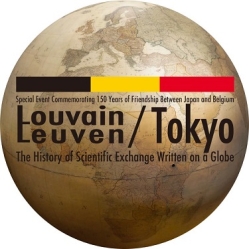“Louvain/Tokyo: The History of Scientific Exchange Written on a Globe”

Details
| Type | Exhibition |
|---|---|
| Intended for | General public / Enrolled students / Applying students / International students / Alumni / Companies / Elementary school students / Junior high school students / High school students / University students |
| Date(s) | October 4, 2016 — November 27, 2016 |
| Location | Other campuses/off-campus |
| Venue | Intermediatheque 2F [COLONNADE2] [Address]KITTE 2-3F, 2-7-2 Marunouchi, Chiyoda-ku, Tokyo, JAPAN [Access]JR lines and Tokyo Metro Marunouchi line Tokyo Station. Direct access from the Marunouchi Underground Pathway. [Opening Hours]11:00 - 18:00 (Open until 20:00 on Fridays and Saturdays) Last admission 30 minutes before closing. *Opening hours may change. [Closed on]Mondays (or the following Tuesday if Monday is a National Holiday) and Year-end holidays. May close irregularly. |
| Entrance Fee | No charge |
| Registration Method | No advance registration required |
| Contact | +81 3 5777 8600 (Hello Dial) |
※The exhibition end date listed above is tentative.
2016 marks the 150th anniversary of the establishment of diplomatic relations between Japan and Belgium. On this occasion, and in the hope of further developing scientific relations between both countries, the Intermediatheque hosts a small exhibit featuring the large-sized geographical globe shown in the museum’s Colonnade space.
Globe Produced by the Belgian Royal Association of Geography (Scale 1:8,000,000)
With the Great Kanto Earthquake in September 1923, Tokyo Imperial University suffered a vital blow. It is said that more than 500,000 books were reduced to ashes. This tragic situation was immediately reported abroad. As various countries offered their support, Belgium proposed donations and books to Tokyo Imperial University.
The head of Tokyo Imperial University decided to allot this donation money to the production of a geographical globe. By displaying it in the newly constructed library, he intended to perennially commemorate Belgian citizens’ kindness. However, production took a longer time than expected, and the globe eventually arrived from Belgium at the end of 1937. By then, the times were gloomy, with the outburst of the Second Sino-Japanese War. Despite this international situation in the face of imminent military conflict, the Belgian citizens did not break their promise made fifteen years earlier.
There is a prologue to this story. In the middle of the First World War, the German army irresistibly pursued its invasion of Belgium. The brutality of the German army, resulting in the burning of 300,000 books, shocked the whole world. After the war, the member states of the League of Nations led a project aimed at reconstructing university libraries. A national committee was also established in Japan, directed by Mankichi Wada, a professor at the Faculty of Letters of Tokyo Imperial University who had studied in the West, and was an authority on Japanese Literature and Library Science.
The Great Kanto Earthquake occurred shortly after. Wada, who had long directed the Imperial University Library, assumed the responsibility of the books’ destruction and resigned from his position. However, in a mere two years starting from the year following the earthquake, he was able to organize the donation of 14,000 rare books to the Catholic University of Louvain. Belgian citizens were well aware of Japan’s international contribution in this postwar reconstruction project. Belgium’s offer to support Japanese reconstruction following the earthquake can thus be explained by the history of scientific exchange uniting Louvain and Tokyo.
The material proof of this privileged relationship is this globe, which was transferred from the University Library to the University Museum, and is now shown within the Intermediatheque permanent exhibition. On the other hand, the rare books sent by Tokyo Imperial University to Belgium again faced a tragic fate. The Catholic University of Louvain Library, reconstructed with the support of foreign countries, was burned down with its books as it was again devastated by war in 1940.
It is not clear why the globe delivered from Belgium was blank. It was then mentioned that “it was left blank, without any coloring, according to the preferences of the Japanese side.” The coloring was made from 1939 on. We cannot help but wonder how the persons in charge at Tokyo Imperial University felt as they colored the map and marked borders, amidst a febrile international context.
[Organizer] The University Museum, the University of Tokyo (UMUT)
[Support] Embassy of the Kingdom of Belgium








